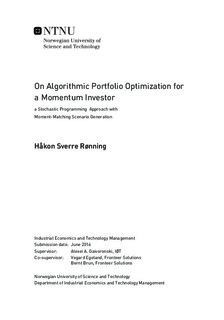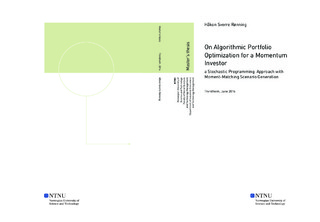| dc.description.abstract | Momentum strategies based on continuation patterns in equity prices have attracted a wide following among money managers and financial investors attempting to exploit anomalies present in the stock market. In this thesis, we first perform out-of-sample tests of four long-only momentum strategies, one contrarian strategy and one low-volatility investment strategy on US and Norwegian equity samples. We find the momentum and contrarian strategies to yield statistically significant abnormal returns on the Norwegian market only, indicating the US market to be more efficient. The highest average monthly returns are found for the individual stock price momentum strategy, and the highest risk-reward performance is yielded by a volatility-scaled momentum strategy. The returns to the strategies are found time-varying and not always positive, suggesting that a momentum investor could benefit from periodically changing strategy or investing in a risk-free instrument.
The second part of this thesis studies the problem facing an investor with funds to allocate between investment strategies in the Norwegian market. We build a stochastic portfolio optimization framework with moment-matching scenario generation, and apply it out-of-sample on portfolios with momentum and contrarian strategies. We find a significant performance increase in adding a contrarian strategy to a portfolio of momentum strategies. By allowing the investor to allocate wealth portion-wise between these algorithms, we generate higher risk-reward performance than both an equally weighted market index and a buy-and-hold benchmark of the constituent strategies. Finally, by forcing the investor to each month choose between a contrarian and a single momentum strategy, we create investment strategies with superior return performance. In particular, we find a contrarian strategy in combination with an individual stock price momentum strategy, to yield the highest cumulative and average returns among the strategies tested. These findings from stochastic programming suggest that an investor could benefit from periodically changing between contrarian and momentum investing, exploiting both return reversal effects and continuation patterns in equity prices. | |

